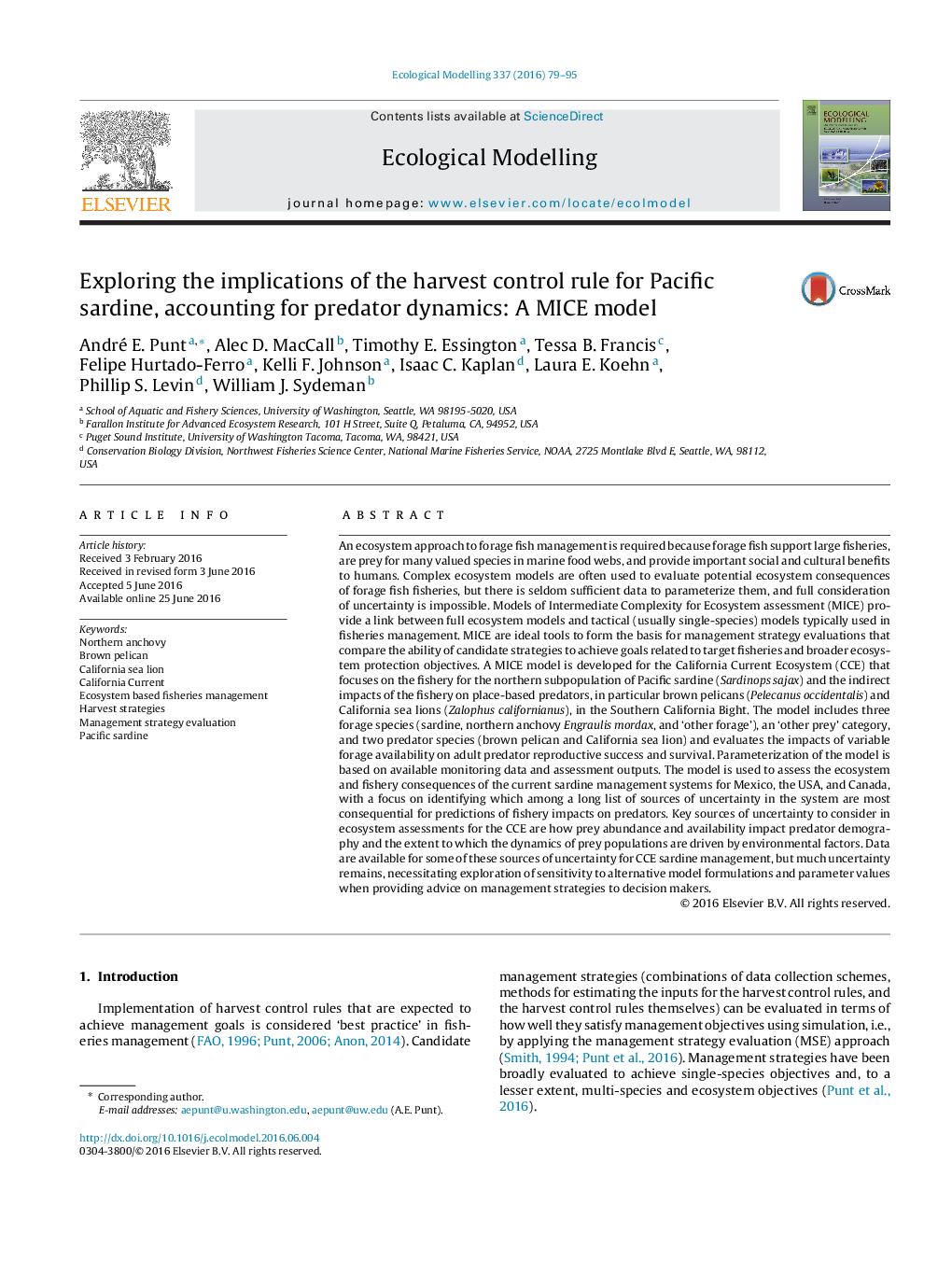| کد مقاله | کد نشریه | سال انتشار | مقاله انگلیسی | نسخه تمام متن |
|---|---|---|---|---|
| 6296056 | 1617410 | 2016 | 17 صفحه PDF | دانلود رایگان |
عنوان انگلیسی مقاله ISI
Exploring the implications of the harvest control rule for Pacific sardine, accounting for predator dynamics: A MICE model
دانلود مقاله + سفارش ترجمه
دانلود مقاله ISI انگلیسی
رایگان برای ایرانیان
کلمات کلیدی
Northern anchovyManagement strategy evaluation - ارزیابی استراتژی مدیریتHarvest strategies - استراتژی های برداشتPacific sardine - ساردین اقیانوس آرامCalifornia sea lion - شیر شیرین کالیفرنیاEcosystem based fisheries management - مدیریت ماهیگیری مبتنی بر اکوسیستمCalifornia Current - کالیفرنیا جاری است
موضوعات مرتبط
علوم زیستی و بیوفناوری
علوم کشاورزی و بیولوژیک
بوم شناسی، تکامل، رفتار و سامانه شناسی
پیش نمایش صفحه اول مقاله

چکیده انگلیسی
An ecosystem approach to forage fish management is required because forage fish support large fisheries, are prey for many valued species in marine food webs, and provide important social and cultural benefits to humans. Complex ecosystem models are often used to evaluate potential ecosystem consequences of forage fish fisheries, but there is seldom sufficient data to parameterize them, and full consideration of uncertainty is impossible. Models of Intermediate Complexity for Ecosystem assessment (MICE) provide a link between full ecosystem models and tactical (usually single-species) models typically used in fisheries management. MICE are ideal tools to form the basis for management strategy evaluations that compare the ability of candidate strategies to achieve goals related to target fisheries and broader ecosystem protection objectives. A MICE model is developed for the California Current Ecosystem (CCE) that focuses on the fishery for the northern subpopulation of Pacific sardine (Sardinops sajax) and the indirect impacts of the fishery on place-based predators, in particular brown pelicans (Pelecanus occidentalis) and California sea lions (Zalophus californianus), in the Southern California Bight. The model includes three forage species (sardine, northern anchovy Engraulis mordax, and 'other forage'), an 'other prey' category, and two predator species (brown pelican and California sea lion) and evaluates the impacts of variable forage availability on adult predator reproductive success and survival. Parameterization of the model is based on available monitoring data and assessment outputs. The model is used to assess the ecosystem and fishery consequences of the current sardine management systems for Mexico, the USA, and Canada, with a focus on identifying which among a long list of sources of uncertainty in the system are most consequential for predictions of fishery impacts on predators. Key sources of uncertainty to consider in ecosystem assessments for the CCE are how prey abundance and availability impact predator demography and the extent to which the dynamics of prey populations are driven by environmental factors. Data are available for some of these sources of uncertainty for CCE sardine management, but much uncertainty remains, necessitating exploration of sensitivity to alternative model formulations and parameter values when providing advice on management strategies to decision makers.
ناشر
Database: Elsevier - ScienceDirect (ساینس دایرکت)
Journal: Ecological Modelling - Volume 337, 10 October 2016, Pages 79-95
Journal: Ecological Modelling - Volume 337, 10 October 2016, Pages 79-95
نویسندگان
André E. Punt, Alec D. MacCall, Timothy E. Essington, Tessa B. Francis, Felipe Hurtado-Ferro, Kelli F. Johnson, Isaac C. Kaplan, Laura E. Koehn, Phillip S. Levin, William J. Sydeman,